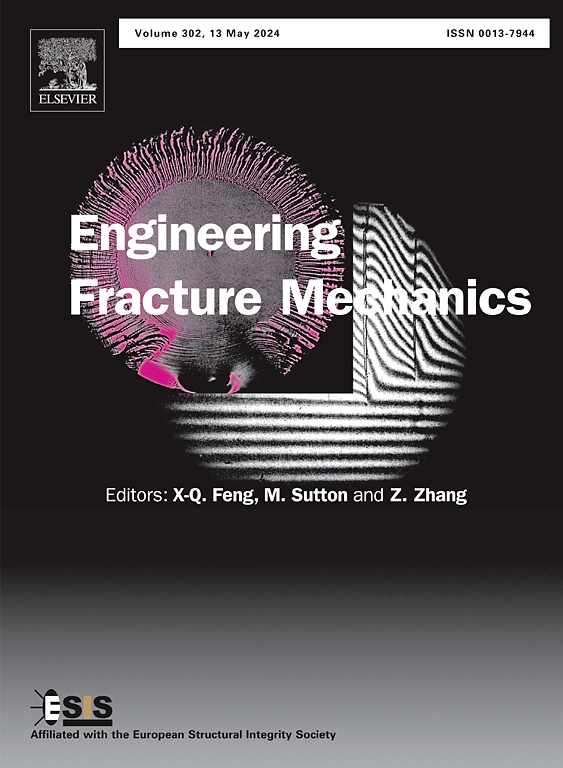Acoustic emission-based identification and interfacial fiber bridging and delamination damage mechanisms in twill/unidirectional composite materials
IF 4.7
2区 工程技术
Q1 MECHANICS
引用次数: 0
Abstract
Interlaminar damage in carbon fiber reinforced polymer (CFRP) laminates is a common form of damage in engineering applications, with interlaminar fracture toughness commonly used to characterize its ability to resist crack propagation. In double cantilever beam (DCB) tests of CFRP laminates, the intensity of fiber bridging phenomena depends on the structure and orientation of fibers on either side of the delamination. To further elucidate the mechanism of fiber bridging phenomena in delamination crack propagation, DCB specimens with pre-fabricated cracks on either side composed of twill-weave (TW) fiber layers and unidirectional (UD) fiber layers were employed to study the delamination behavior of two fiber orientations. An unsupervised k-means clustering algorithm was employed for identifying damage modes from acoustic emission(AE) signals under different failure modes, and the relationship between the interlaminar fracture toughness of the specimens and interlaminar micro-damage was analyzed. Scanning electron microscopy (SEM) was used to reveal the micro-mechanisms of damage. The results indicate that the trend of interlaminar fracture toughness of the specimens is positively correlated with the peak amplitude of AE signals. Cluster analysis categorizes AE signals into matrix damage (including matrix cracking, interface debonding, and fiber pull-out) and fiber bridging damage (fiber breakage). Cluster analysis revealed that differences in interlaminar fracture toughness among interfaces stem from varying matrix fracture modes. Acoustic AE technology was used to distinguish the lamination mechanism between specimens from micro and macro perspectives, which provides an important basis for determining the mechanical properties of composite laminates.
基于声发射的斜纹/单向复合材料界面纤维桥接与分层损伤机理研究
碳纤维增强聚合物(CFRP)层间损伤是工程应用中常见的一种损伤形式,层间断裂韧性通常用来表征其抗裂纹扩展的能力。在CFRP复合材料双悬臂梁(DCB)试验中,纤维桥接现象的强度取决于分层两侧纤维的结构和取向。为了进一步阐明分层裂纹扩展过程中纤维桥接现象的机理,采用由斜纹织(TW)纤维层和单向(UD)纤维层组成的两侧预制裂纹的DCB试样,研究了两种纤维取向的分层行为。采用无监督k均值聚类算法从不同破坏模式下的声发射信号中识别损伤模式,分析了试件的层间断裂韧性与层间微损伤的关系。利用扫描电子显微镜(SEM)研究了损伤的微观机理。结果表明:试样的层间断裂韧性变化趋势与声发射信号峰值幅值呈正相关;聚类分析将声发射信号分为基体损伤(包括基体开裂、界面脱粘、纤维拔出)和纤维桥接损伤(纤维断裂)。聚类分析表明,界面层间断裂韧性的差异源于基体断裂模式的不同。利用声发射技术从微观和宏观两方面对试样的层合机理进行了区分,为确定复合材料层合板的力学性能提供了重要依据。
本文章由计算机程序翻译,如有差异,请以英文原文为准。
求助全文
约1分钟内获得全文
求助全文
来源期刊
CiteScore
8.70
自引率
13.00%
发文量
606
审稿时长
74 days
期刊介绍:
EFM covers a broad range of topics in fracture mechanics to be of interest and use to both researchers and practitioners. Contributions are welcome which address the fracture behavior of conventional engineering material systems as well as newly emerging material systems. Contributions on developments in the areas of mechanics and materials science strongly related to fracture mechanics are also welcome. Papers on fatigue are welcome if they treat the fatigue process using the methods of fracture mechanics.

 求助内容:
求助内容: 应助结果提醒方式:
应助结果提醒方式:


